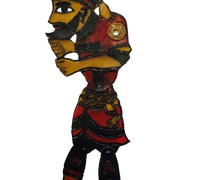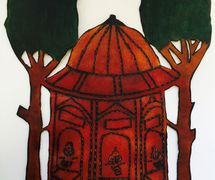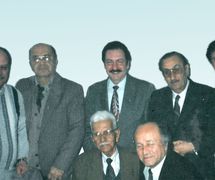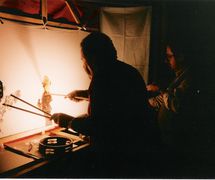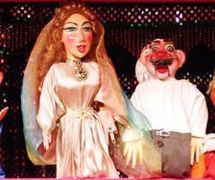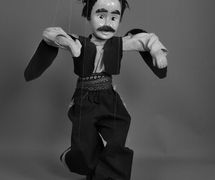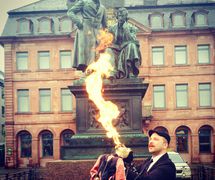The Republic of Turkey (Turkish: Türkiye Cumhuriyeti) is located in Western Asia, with the portion of Eastern Thrace located in South-Eastern Europe. The country is bordered by Bulgaria, Greece, Georgia, Armenia, Iran, Azerbaijan, Iraq, and Syria, with the Mediterranean Sea, Aegean Sea and Black Sea along its south, west and north coasts and the Sea of Marmara, the Bosphorus and the Dardanelles marking the boundary between Thrace and Anatolia. The country’s location at the crossroads of Europe and Asia has greatly influenced this region’s long history since the Paleolithic age. In the 11th century, Seljuk Turks migrated into the area, starting the process of Turkification: introducing into Anatolia the Turkish language and Islam. From the late 13th century to the early modern period, the Ottomans united Anatolia and created a vast empire, which included most of South-Eastern Europe, Western Asia and North Africa. The modern Republic of Turkey was established in 1923, with Mustafa Kemal Atatürk as its first president.
In the Turkish cultural heritage one of the most popular forms of traditional art is karagöz, shadow theatre named after the principal character, Karagöz. The play was originally called chadar hayal or zýllý hayal (literally, “shadow phantoms”) but is now called karagöz oyunlari (Karagöz plays). The coloured figures of shadow puppetry may have appeared earlier and be prototypes of comic Turkish improvised popular theatre (orta oyuni). Live plays and three-dimensional puppets, too, continually exercised a powerful influence on each other and must be studied in relation to one another. All reflect Ottoman society in its multiplicity and its transformations.
The Theatre of Shadows
Researchers have offered various views on the origins of Turkish shadow theatre. Some claim it was first passed on from China by way of India. Later, that it was taken by the Mongols from the Chinese and transmitted to the Turkic peoples of Central Asia: in this way, the art was brought to Anatolia by Turkic peoples emigrating there from Central Asia. Certainly, shadow theatre passed through Central Asia. However, one does not currently find the form there or in Iran; today, both regions have only three-dimensional puppets. Other scholars see Central Asian shamanism as a root for shadow theatre and puppetry. It was from the pre-Islamic, Central Asian and Ural-Altaic Turkic cultures that the Turkish nation derived its origins. Before their conversion to Islam, the peoples of those cultures practised animism and shamanism, and among Central Asian Turks, puppets were used for magic purposes as well as for entertainment. During the long period that the Turks resided in Central Asia, performances had links to magical rituals, thus we find terms for puppets like çadır hayal (marionette), kol korçak (glove puppet); the term kukla for a figure only appears in the 17th century.
Some scholars find an origin for shadow play in 14th century Bursa (north-western Anatolia), during the period of Sultan Orhan. The origin of the genre there routinely is attributed to Sheik Küsteri, a holy man and artist, considered the patron saint of the artist. Although many legends circulate, there is no written source on the karagöz prior to the 16th century, when Egypt is cited as a site for its introduction into the Turkish world.
Yavuz Sultan Selim conquered Egypt (1517) and was impressed by its puppetry when he saw a shadow show performed in his honour. He brought an Egyptian puppet master back to his palace. Egypt may at least have contributed to the art. There are resemblances in the structure of performances (four sections: mukaddime or introduction, muhavere or dialogue between the main characters, fasil or play with story, and bitiş or finale) and themes introduced. However, the Egyptian monochromatic, static figures became mobile Turkish characters in living colour, and so after shadow puppetry came to Anatolia it was modified into a new type of art by Turkish artists who made it wholly their own. If we look at the Egyptian repertoire of Ibn Daniel (1238-1310, poet and man of the theatre, author of the oldest shadow plays in Arabic), the play Tayof el khayal (Spirit of Shadow) which details a rake’s progress and marriage, we can compare it to karagöz’s Sahte Gelin (The False Bride), and in Ibn Daniel’s El Moutayyam (The Lovers), the homosexual humour reminds us of karagöz’s Odülllü (The Wrestler) where the fool banters with the dwarf Bebe Ruhi. Themes at least persist.
It is in Anatolia that the genre found its present form. It expanded and played in cities from on the coast of the Black Sea to the Mediterranean, and thrived in Istanbul where the socio-economic conditions were most favourable for its development. Some also hypothesize that the Jewish entertainers of the late 15th and early 16th century as inquisition refugees in Ottoman Turkey contributed to its development as they did with other popular theatre and entertainments.
Thus, shadow theatre gained great popularity among the Turks, and the puppeteers worked to improve the techniques they had inherited from others. The Turkish shadow play was given the names Chadar Hayal, Zilli Hayal, and Hayal-Zill, meaning “shadow phantoms” or “phantoms of shadow”. More recently, however, the Turkish shadow theatre has come to be known as Karagöz Oyunları (Karagöz Plays), after the main character, Karagöz.
The Literary Reports
In the 17th century, Evliya Çelebi, in his famous Seyahatname (Book of Travels), gave information on players, play subjects, and characters, as in the plays Hamam (Turkish Bath) where Karagöz and company get burned in a bath house fire, or Kanlı Nigâr (The Impetuous Flirt) where two courtesans trick and disrobe Karagöz. Material in the play is clever and often vulgar, and, as with the noted Turkish poet Nefi (1572-1635) in his Sihâm-ı Kaza (Arrows of Misfortune), the works are coarse, satire-filled portraits of the grotesque.
Little by little, the classic repertoire was enriched with new characters, while costume iconography evolved as well. The Ottoman sources and illustrated miniatures (surname) are rich evidence of performances at court for the births, circumcisions, marriages and accessions of the rulers, as well as receptions of ambassadors or foreign guests. The karagöz theatre appears in the travel accounts of Western authors such as Jean Thévenot (1656), Gérard de Nerval (1843), Théophile Gautier (1854), Charles d’Agostino (1911), and André Antoine (1914). These foreign authors are startled by the crude jokes and seeming immorality of the presentations.
The Karagöz Theatre, its Characters and its Influence
The principal protagonist of the Turkish shadow theatre, Karagöz, has a bald head and round face with a large black eye. He normally wears an ıskırlak hat and represents the uneducated and straight-speaking commoner. His counterpoint, Hacivat, is a smooth talking, upper class operator. Both are said to have been real people who helped build the Ulu Cami (Great Mosque) in Bursa, with Karagöz a worker and Hacivat, the foreman. Supposedly, both were executed by Sultan Orhan Bey (d.1361) when construction was not completed on schedule. The ruler regretted his cruel judgment and the aforementioned Sheik Kusteri “revived” the pair in a shadow play, entertaining the sultan and establishing an art full of wordplay, misunderstandings, ethnic parodies, fights, and pratfalls.
The characters represent the communities of the Ottoman Empire. Events and people are seemingly superficial and comic, but the stereotypical and therefore important characters are emphasized and deliver the puppeteer’s messages to the audience, including social critiques and timely political humour. Stock characters are Çelebi (dandy), Tiryaki (opium addict), Bebe Ruhi (dwarf), Kastamonulu (Baba Himmet, a woodcutter from Kastamonulu), Kayserili (man from Kayseri), Karadenizli (man from Laz by the Black Sea), Rumelili (Balkan man), Kurd (Kurdish night watchman), Matiz (brother-in-law to Karagöz), Acem (Persian), Albanian, Armenian, Jew, Greek or Frank (European), Zenne (Female), and Çengi (Gypsy Woman Dancer). In all of the plays, comic speech and action are foregrounded. Irony, misunderstandings, and accents abound. Characters from each area use their own in their own local argot. Fights, pratfalls and collisions accelerate the comic action.
The screen (ayna or “mirror”) shows the hide figures (tasvir), which are 32-40 centimetres in height. The music of the group each figure represents – Jewish, Greek, Armenian, etc. – sounds as the character comes on screen. There are about sixty scripts in the repertoire. Most are inspired by daily life in the capital and the cities of Anatolia. Plays describe the traditions, manners, customs, fashions, dialects/ethnic groups, and trades and reflect the views and preoccupations of the varied urban society. No character escapes parody. There is vulgar language, brazen acts, allusions to real events and issues of the era, as well as critiques of the arbitrary government. For example, the character of Efe or Zeybek (from Southwest Anatolia), the defender of the oppressed and poor, is seen with ammunition belts slung across his chest. He is, in fact, a legendary brigand named Çakırcalı who gained prominence despite the efforts of ministers of Sultan Abdül Hamid II (1842-1918). Tuzsuz Deli Bekir is the terror of the authorities of the district: knife in one hand and a carafe of wine in the other, he is a Janissary (Greek mercenary), a comic righter of wrongs, a braggart, and drunkard.
Satire, jokes, and raillery against authorities fuelled political agitation: pashas, viziers, beys, and religious and military figures are targeted and reviled. Still, these elite figures are not themselves presented, unlike in the Greek karaghiozis.
Corresponding theatres developed wherever the Ottoman held sway including in the Balkans, North Africa, and areas of the Middle East. In each site, a Turkish model was adapted by local artists to local needs. By the 18th century, the art was found in pavilions and palaces, cafes and gardens.
The popularity of karagöz in the Ottoman capital sometimes upset the civil and religious authorities. They feared the irreverence, satirical spirit, and lack of constraint in the shows. But aside from the caricature and rebellion, the theatre is invested with a philosophical character that looks toward mysticism: the screen represents the universe, under the will of the Divine (represented by the puppeteer), with each human only a passing shadow. The theatre reveals the mystical thought of the Sufi as adapted for the popular audience. Without denying its ludic aspects, the karagöz is invested with import. Some plays deal with star-crossed lovers, as Kerem and Asli, where religion divides a Muslim lover and his Armenian girl; Tahir and Zühre is a tale of lovers engaged from the cradle but prevented from wedding by a conniving stepmother; Arzu and Kanber is about a khan’s daughter raised as a male and her lower class beloved; Ferhat and Şirin is a play concerning a craftsman who brings water via a canal to win his beloved Lady Şirin but is cheated of her hand; in Leyla and Mecnun the hero goes mad when denied union with the beautiful Leyla. Performances can parody and mock the themes from these great love stories of legend. The romantic and tragic are treated via farce and these major heroes act like base mortals. Other works are free adaptation of Molière (Tartuffe, Tricks of Scapin, The Miser, and The Doctor in Spite of Himself) with some scenes cut and wordplay and tomfoolery enhanced.
All performers had at least 28 plays for the number of evenings of the month of Ramadan, when artists presented a different show each night. According to tradition, the first night would be Yalova Safasi (Pleasure Trip to Yalova) wherein a young couple is going on a journey and others suitors hide from the girl’s fiancé in a trunk and jar. The last night of the month of Ramadan would be Mehane (The Tavern), announcing the end of the fast and return to libations as Bekri Mustafa mocks the forbidden; this celebrated drunkard supposedly lived during the reign of Sultan Murat IV (1623-1640) and his excesses became a butt of popular jokes. He, as other shadow types, is also present in the storyteller (meddah) tradition, the puppetry (kukla) and the “play in the open” (orta oyuna). This latter form was born toward the end of the 18th century – all roles were played by males – and as previously mentioned it took characters, plays, and comic inspiration from the shadow model.
With these different performances, Ottoman society cast upon itself an ironic eye, taking in the grotesque portrait gallery of figures. The form began to decline in the 19th century. After the fall of the Ottoman Empire with the introduction of European culture and theatre, the influence of radio, cinema, and television, the audiences turned away from the popular theatre of the past. There was revival at the establishment of the Republic of Turkey (1923), bringing it to life again. Efforts to keep shadow theatre alive today come from the Ministry of Culture and Tourism, UNIMA Turkey, and artists. Since karagöz is still a traditional art in Turkey, new artists are trained by the older masters.
A Profession in Transformation
Talented past masters, notably Mehmet Muhittin Sevilen (Hayali Küçük Ali), Irfan Açıkgöz (Hayali Camcı Irfan), Mazhar Gençkurt (Mazhar Baba), all practised the art, perpetuating the tradition. Thanks to writers and specialists like Helmut Ritter, Aziz Nesin, Cevder Kudret, Ismail Hakkı, Baltacıoglu, Selim Nüshet Gerçek, Mustafa Nihat Özön, Nurettin Sevin, Sabri Esat Siyavuşgil, Pertev Boratav, Hadi Poyrazoğlu, and Metin And, karagöz has experienced a certain revival. The plays of the repertoire have been modernized, plots organized, the performers have composed scripts placing the heroes in the contemporary world, for example Karagöz at the Cinema, Karagöz as Photographer, or Karagöz in the Aeroplane, etc. The performers, some of whom have an international reputation such as Tacettin Diker, Orhan Kurt, Metin Özlen, Tuncay Tanboğa (Hayali Torun Çelebi), have revived the traditional theatre that “for the eyes of the profane reflects an image, but for those initiated to the symbols represents the true”. At the same time some of them like Talat Dumanlı, Nevzat Açıkgöz, Hadi Poyrazoğlu, Aram Çerçi, or Selim Başeğmez manipulate puppets (kukla), both string puppets and glove puppet figures, in which the figures are based on the types from the shadow theatre: as the clown figure Ibiş is to Karagöz, so Ihtiyar is to Hacivat.
More recently, there are works created by Divlet Tiyatrosu Gölge Oyunu Grubu (State Theatre for Shadow Play) by Mustafa Mutlu, Istanbul Kukla ve Karagöz (Istanbul Puppet and Karagöz) by Ünver Oral (member of UNIMA and writer of popular theatre books), The Başkent Kukla Tiyatrosu (Baskent Puppet Theatre) by Tahir Ikiler, Geleneksel Tiyatro Topulugu (Traditional Comic Theatre) by Ihsan Dizdar, the Bursa Karagöz Tiyatrosu (Bursa Karagöz Theatre) by Şinasi Çekikkol who also regularly organizes a festival in that city, generally in November. In addition, there is Traditional Show Arts Group of Mahmut Hazim Kisakürek, Theatre Tempo of Haluk Yüce, Üsküdar Karagöz Theatre by Alpay Ekler, among others.
Today, the number of shadow performers and professional puppeteers can be counted on the fingers. More numerous than this are the semi-professionals and amateurs who continue to love the figures and their sparkling colour. They play privately for family festivities and in public for daycare centres, schools, cultural centres, radio programmes and television, at conventions, fairs, national and international festivals.
The country has many collections found in the three major cities: in Ankara, at the National Library (Milli Kütuphanesi), Ministry of Culture and Tourism of the People’s Archive (Kültür ve Turizm Bakanlıgı Halk Kültürü Arşivi), Hacettepe University State Conservatory (Hacettepe Üniversitesi Devlet Konservatuarı), Ankara Museum of Ethnography (Ankara Etnografya Müzesi), the Deciption Collection of UNIMA Turkey National Center (UNIMA Türkiye Milli Merkezi Tasvir Koleksiyonu); in Istanbul, at the Istanbul Municipality Museum (İstanbul Büyükşehir Belediyesi Müzesi), Academy of Fine Arts (Güzel Sanatlar Akademisi), Faculty of Letters (Edebiyat Falültesi), Collection Hazim Körmükçü/Behzat Butak, Construction and Credit Bank (Yapı ve Kedi Bankası), Yilsiz and Topkapi Palace Museums, and the City Museum; and in Bursa, at the Museum of Islamic Art (Türk Islam Eserler Müzesi) and House of Karagöz in Bursa (Bursa Karagöz Evi).
Other Puppetry Forms
Other Turkish forms are less known although the Turkish term kukla and its variants have travelled throughout Central Asia. During the Ottoman period iskemle kuklası (jigging puppet) were presented on the street. A string passed through the breast of the figure and was attached to a post or the performer’s chair and made to dance to the showman’s music. El kuklasí (glove puppets) and ipli kukla (string puppets) are often attributed to the touring shows of Englishman Thomas Holden, but of course are probably older as we find Central Asian antecedents for these forms. In glove puppets, the main characters are the servant (Ibis) and the old man (Ihtiyar), whose roles, as noted earlier, parallel Karagöz and Hacivat, respectively. In the orta oyuna the names of these main figures change to Kavuklu and Pisekar respectively. The low hero who mocks and wins the girl prevails. Another form of traditional Turkish puppets is the giant figures with manipulators hidden below that parade in street processions.
The Turkish branch of UNIMA (UNIMA Türkiye) was created in 1990. Professor Metin And (d.2008), an author and professor in the Department of Drama in Ankara and the owner of his own collection including a number of examples of figures by Ragıp Tuğtekin, became the first president. The journal Unima Karagöz comes out three times a year. The 2012 president of UNIMA Turkey is Mevlüt Özhan, the vice president is Orhan Kurt, with Mustafa Mutlu as general secretary. These three were part of the team winning the UNESCO designation for Turkish shadow puppetry as a Masterpiece of the Intangible and Oral Heritage of Humanity, and activities to preserve the art have accelerated since the declaration in 2009.
Western style puppet performances have also developed in Turkey and are often presented for child audiences. Istanbul (Istanbul International Puppet Festival, Bursa (International Bursa Karagöz Puppet and Shadow Theater Festival), Izmir (Izmir Puppet Days) and other cities have major puppet festivals, which feature traditional and contemporary puppet work with shows like The Garbage Monster, The Magic Tree, and more traditional works like Ferhat and Sirin, among others.
Bibliography
- And, Metin. A History of Theatre and Popular Entertainment in Turkey. Ankara: Forum Publications, 1963.
- And, Metin. Karagöz. Théâtre d’Ombres Turc. Ankara: Éditions Dost, 1977.
- And, Metin. Karagöz. Turkish Shadow Theatre. Ankara: Dost Yayinlari, 1979; 3rd ed., 1987.
- And, Metin. “Turkish Shadow Theatre: Karagöz”. East Asian Cultural Studies. No. 15 (March), 1976, pp. 77-86.
- And, Metin. Drama at the Crossroads: Turkish Performing Arts Link Past and Present, East and West. Istanbul: Isis Press, 1991.
- Başgöz, İlhan. “Earlier References to Kukla and Karagöz”. Turcica, Revue d’Etudes Turques. Vol. III:9-21, 1972.
- Bergstrasser, G. “Türkische Schattenspieler” [Turkish Shadow Players]. Orientalisches Literaturzeitung. Vol. 28, 1925, pp. 424-431.
- Dejeux, Jean. Djoh’a, héros de la tradition orale arabo-berbère hier et aujourd’hui [Djoh’a, Hero of the Arab-Berber Oral Tradition Yesterday and Today]. Sherbrooke (QC): Naaman, 1978.
- “Karagoz”. [Slideshow, video] http://www.unesco.org/culture/ich/index.php?RL=00180. Accessed 15 July 2012.
- Jacob, Georg. Geschichte des Schattentheaters im Morgen- und Abendlande [History of Shadow Theatre in the East and West]. Hannover: Lefaire, 1925.
- Kudret, Cevdet. Karagöz. Istanbul: Yapı Kredi Yayınları, 2004.
- Koz, M. Sabri, ed. Yıktın Perdeyi Eyledin Vîrân, Yapı Kredi Karagöz Koleksiyonu Torn is the Curtain, Shattered is the Screen, the Stage all in Ruins. Yapı Kredi Karagöz Collection. Istanbul: Yapı Kredi Yayınları, 2004. (In Turkish and English)
- Kunos, I. “Türksches Puppentheater” [Turkish Puppet Theatre]. Ethnologische Mitteilungen aus Ungarn. 1889, pp. 148-158.
- Martinovich, Nicholas. The Turkish Theatre. Bloomington: Indiana Univ. Press, 1968.
- Menzel, Theodor. Maddah, Schattentheatre und Orta Oyunu [Maddah, Shadow Theatre and Orta Oyunu]. Prague: Orientalisches Institut, 1941.
- Nicolas, Michèle. “Karagöz: le théâtre d’ombres turc”. Les Marionnettes. Ed. Paul Fournel. Paris: Bordas, 1982; rpt. 1985 and 1995.
- Oral, Ünver. Türkish Shadow Play Karagöz. Ankara: Republic of Turkey, Ministry of Culture and Tourism Publications, 2009.
- Mevlüt, Özhan, ed. The Traditional Turkish Theatre. Ankara: Ministry of Culture Publications, 1999.
- Mevlüt, Özhan. “Karagöz’ün Dünya Gölge Tiyatrolarına Etkisi” [Influence of the World of Karagöz Shadow Theatres]. 6th International Congress on Turkish Culture, V.4. Ankara, 2009, s. 1901-1910.
- Mevlüt, Özhan. “Karagöz’de Çok Kültürlülük” [Karagöz Multiculturalism]. 7th International Congress on Turkish Culture, V.4. Ankara, 2011.
- Mevlüt, Özhan. “Kültürel Miras Olarak Karagöz” Edebiyat ve Eleştiri [Karagöz as Cultural Heritage “Literature and Criticism”]. Mart – Nisan, 2009, Sayı 99, pp. 12-47.
- Ritter, Hellmut. Karagös Türkische Schattenspiele [Turkish Karagöz Shadow Plays]. Hannover: Lafaire, 1942.
- Senyer, Emin. “Traditional Turkish Shadow Play”. http://www.karagoz.net/english/shadowplay.htm. Accessed 22 February 2012.
- Siyavuşgil, Sabri Esat. Karagöz: Its History, Its Characters, Its Mystical and Satirical Spirit. Istanbul: Turkish Press, 1961.
- Thalasso, Adolphe. Molière en Turquie. Étude sur le théâtre de Karagueuz [Molière in Turkey. Study on the Karagueuz Theatre]. Paris: Tresse et Stock, 1888.
- Tietze, Andreas. Turkish Shadow Theatre and the Puppet Collection of the L.A. Mayer Memorial Foundation. Berlin: Mann, 1977.
- Ulusoy, Mehmet. “Au temps du théâtre de rue” [At the Time of Street Theatre]. Puck. No. 3. Charleville-Mézières: Éditions de l’Institut international de la marionnette, 1990.
- UNIMA Turkey (in Turkish with some English). www.unima.org.tr. Accessed 15 July 2012.















